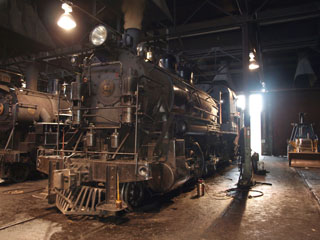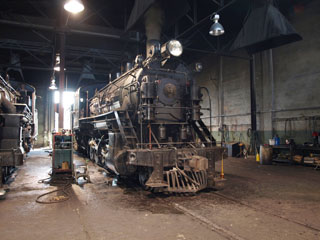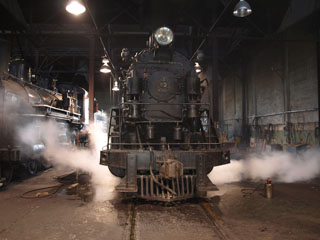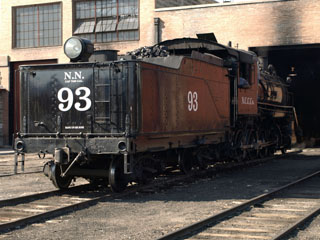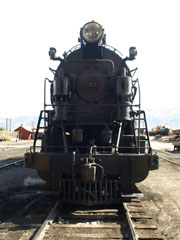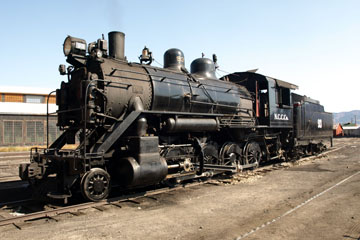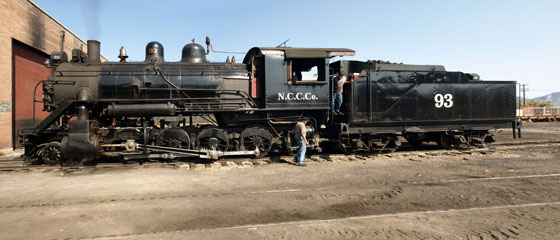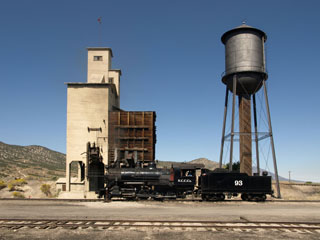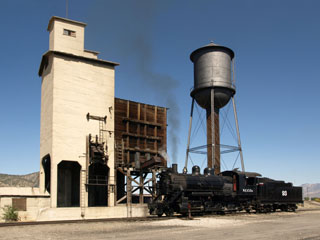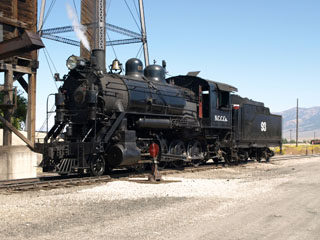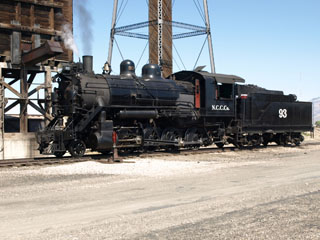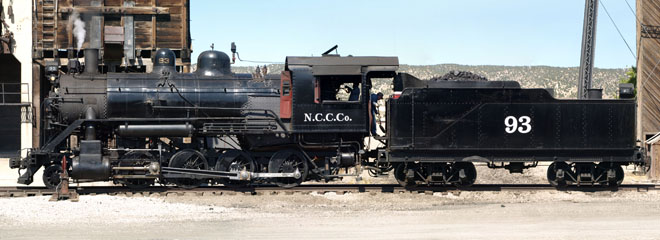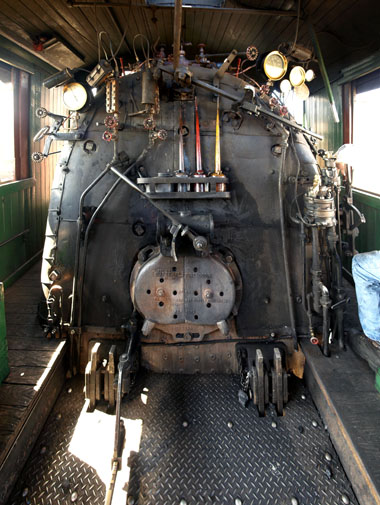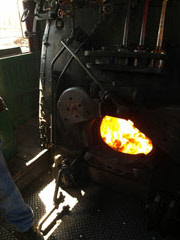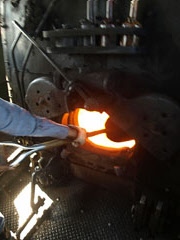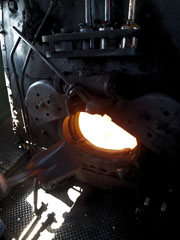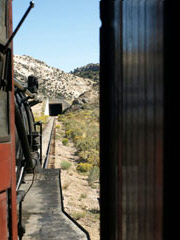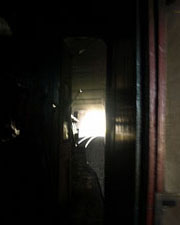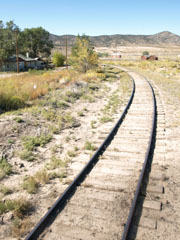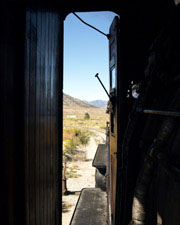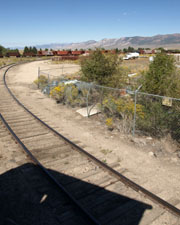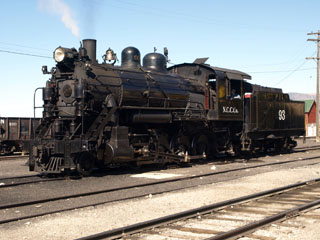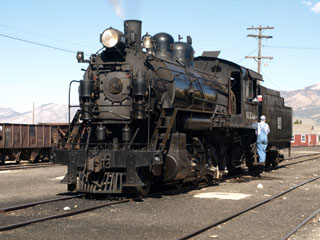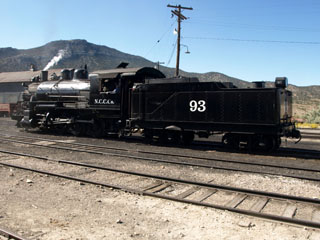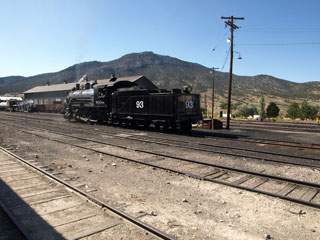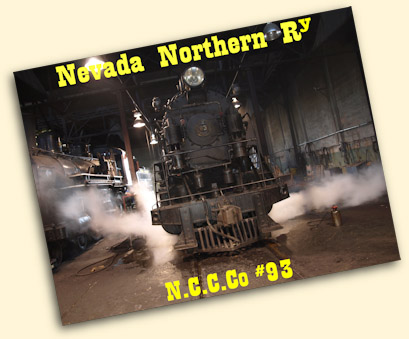

The Nevada Northern Railway was built to service
the large copper deposits discovered in eastern Nevada in the 1900s. Incorporated in June 1905, the Nevada Consolidated Copper Company contracted
to build a line connecting its mines and smelter near Ely to the Southern Pacific at Cobre, NV. Construction began in September 1905 and the line was completed a year later.
The railroad's main purpose was to haul copper ore, but it also handled other freight and a daily
passenger train ran between East Ely and Cobre
until 1941.
From the 1920s, the Kennecott Copper Corporation progressively took over the mining company. Then, in the late 1970s, Kennecott began closing facilities and, in 1983, finally suspended all operations. Three years later, it transferred the local ore line and the yard and shop facilities in East Ely to the White Pine Historical Railroad Foundation, a non-profit organisation which today operates the property as the Nevada Northern Railway Museum.

I visited the Nevada Northern in October 2009 to experience the museum's Engineer Rental programme.
Above, the rear of Nevada Northern Consolidation (2-8-0)
type #93's tender just inside the engine house. This is one of two steam locomotives operated by the museum to haul
local passenger excursions and freight photo shoots. The other locomotive is a Ten Wheeler (4-6-0) type, Nevada Northern #40.
In the view above, #93 is steaming up ready for the day's work. I got behind the throttle later that day and took the locomotive out to Keystone and back.

Above, a view looking along #93's tender just inside the engine house. The tender weighs 115,080 lbs light. It holds 7,500 gallons of water and 12 tons of coal.
#93 is a one of four Consolidations built by Alco in 1909 for the American Smelters Securities Co., to haul ore trains on the Nevada Northern Railway at a cost of $17,610. The locomotive weighs 187,000 lbs, 168,000 lbs on its drivers, and has 51" drivers and
21" x 30" cylinders. A coal burner operating at a boiler pressure of 190 psi it delivers 41,890 lbs tractive effort.
#93 was sold to Nevada Consolidated
Copper in May 1920 when the company took over operation of the ore line. The trackage remained the property of the Nevada Northern Railway who provided
management for operations by Nevada Consolidated train crews. In 1952, three of the original four locomotives supplied by Alco in 1909 were scrapped, but #93 was kept as back up motive power. In 1961, Kennecott Copper donated the locomotive to the White Pine Public Museum, where it went on open air display.
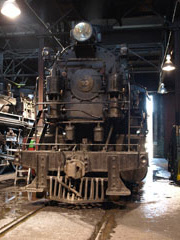

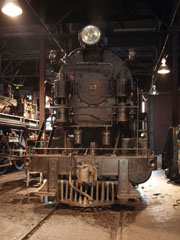
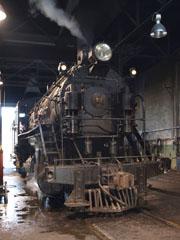
Above, #93's air pumps straddling the smoke box door, give it a characteristically square-jawed look.
in 1990, after twenty-nine years on display at the White Pine Public Museum, #93 was traded by the White Pine Historical Railroad Foundation, along with all of the museum's railroad equipment, to the Northern Nevada Railway Museum in exchange for the Cherry Creek Depot. The depot building was moved fifty miles south to become part of the White Pine Public Museum complex in Ely. The move was funded with the help of $11,000 raised by local elementary school students.
The museum is dedicated to preserving the heritage of White Pine County. It has early County and business records, a doll collection, mineral collection, marine and animal fossils, Native American artefacts, a cell from the old Ely City Jail and a gift shop.
#93 was towed to the Nevada Northern Railway engine house where work got underway to return it to operating condition. In 1993, the locomotive began its second career hauling excursion trains.
Passenger excursions operate on Nevada Northern tracks between Ely, Ruth, and McGill during the summer season, and there are winter photo shoots in February each year. In 2002, #93 was loaded onto a flat car and hauled to Heber City, UT. There, it was part of an "Olympic Steam Team" during the 2002 Winter Games. The day prior to the Opening Ceremony, with Heber Valley Railroad's #618 and #75, #93 triple-headed a train carrying the Olympic flame from Soldier Hollow to Heber City as part of the torch relay.
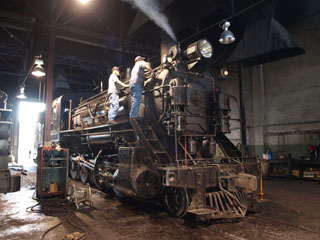
Above, the engineer and one of the hostlers do some final fine tuning before #93 leaves the engine house.
The locomotive has undergone three major overhauls/rebuilds. It needed work in 1995-97, after colliding with a flatcar of ties while on excursion. In 2001, the museum spent over $350,000 to bring the locomotive into compliance with changes to Federal requirements covering boiler maintenance. Finally, in 2007-08, cracked/turned driver axles had to be replaced.
I had hoped to engineer #93 in late 2008, but my plans were scuppered as it stood cold waiting for replacement axles, and #40 was also off the road at that time. Still, it was worth waiting another year for the pleasure of riding #93!
There are two diesel-electric locomotives
also available for rental, 1950 Alco RS-3 #109 and 1956 EMD SD9 #204, as well as the museum's second operational steam locomotive, #40. You can see these and much of the rest of the museum's collection on the Nevada Northern Railway Museum page of this website.
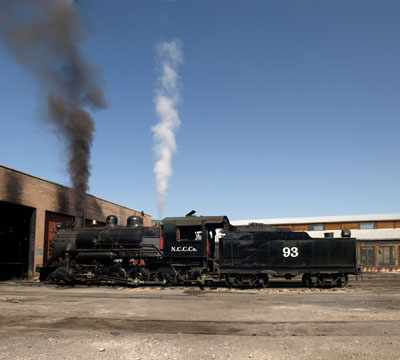
Above, #93 pops its cocks.
The museum's rental programme is limited to people eighteen years of age or older, and usually only
involves engineering the locomotive on its own (i.e. no wagons or carriages are coupled to the locomotive) although, for a higher fee, you can take a train of cars out on your run. The programme includes a period of instruction by one of the museum's certified engineers before you take the throttle, and you must pass a
written examination before you can begin your instruction. The test involves demonstrating your understanding of train orders, signals and braking operations.
You need to wear suitable clothing when you're on the locomotive: a long sleeve all-cotton shirt, all-cotton trousers and a good pair of shoes or boots. And be warned, riding in the cab of an operating steam locomotive involves coal dust, oil and smoke galore!
Back at the yard, you will receive a certificate confirming that have engineered the locomotive.
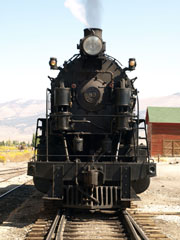

Above and right, #93 in front of the coal tower and sandhouse beside the water tower.
The gradual decline of the mining industry and its remoteness, meant East Ely escaped major modernisation, and it is now one of the best preserved and most complete historic main railroad yard complexes in the US.
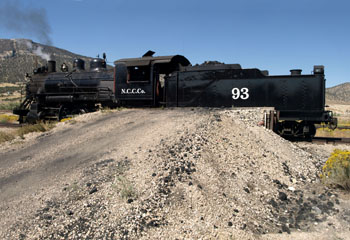

Above, #93 at the coaling station. The original coal tower no longer operates. Instead, locomotives are coaled by front-end loaders, using the ramp shown in these views.
A spur track runs along the north side of the tower where hoppers dumped coal through a grate into a lower bin, from which a bucket lift carried it up to the coal bins. The sand house is part of the tower, and fine sand was dumped in the same way to be carried up to the sand bin. A track, no longer present, ran directly under the tower, from which coal was loaded into tenders through chutes and sand was fed into sand domes through a pipe and hose.

Above, a view looking through the fireman's side window as we stand at the coaling ramp. The old Car Repair Shop is visible straight ahead in this view.
On the right, a composite view of #93's backhead. The engineer has his arm draped over the locomotive brake lever.
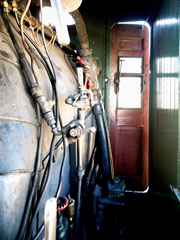
Above, looking through the side window from the engineer's seat. The Johnson Bar handle is poking into view on the lower left.
This is where I first got my hands on #93's throttle, starting with some simple forward and backward movements to get a feel for the controls.
Above, the fireman builds the fire. We need a good head of steam before we get underway.
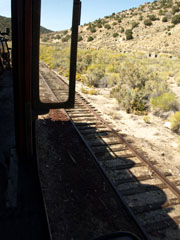
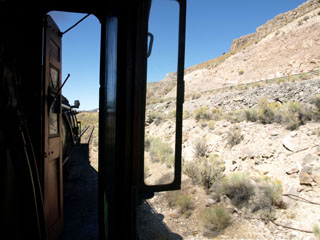
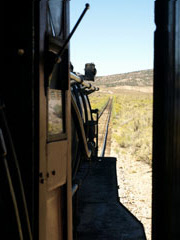
Once we've got our train orders, track warrant and radio approval to proceed, I give two pulls at the whistle, open the cylinder cocks, move the Johnson Bar to the reverse position and nudge the throttle open. A blast of steam breaks from the open cylinder cocks. I pull back another notch on the throttle and #93 starts to move. Another notch out on the throttle and one hundred and sixty-six tons of steel, coal and water start to roll slowly back out of the yard.
After reversing out of the yard, we head forward about a mile north west to Lackawanna crossing before swinging south west to skirt the northern edge of Ely. At the western edge of town, we turn north west up Gleason Creek valley under Garnet Hill (visible at the upper right in the middle view above), beginning the 320' climb to Keystone, seven miles away.
Garnet Hill is part of the Egan Range of
mountains running south from near Schelbourne to Lund, NV. At Ely, Gleason Creek has cut a natural defile through the range, which was
taken advantage of by the old Nevada Northern
to push north to Cobre, where the line interchanged with the original Southern Pacific. State Highway 50 also runs through the defile, heading west.
In the three views above, #93 is stamping up the grade alongside Highway 50 (visible on the right). This part of Highway 50, running from Ely to Fallon, NV, is known as the "Loneliest Road in America".
The name was given by a Life magazine article in July 1986 that portrayed the highway and rural Nevada as a place devoid of civilisation. Officials from White Pine County then chose to capitalise on the publicity and convinced State authorities to use the name as a means of marketing the area. The Nevada Department of Transportation then adopted the name in official highway logs and placed markers along the route. Highway 50 roughly parallels the old Pony Express Trail, remnants of which are still visible in many places along the way.
In getting up to Keystone, my focus is on balancing the extent of throttle with braking so that I stay within the required 15 mph speed range. As the track climbs and levels, this requires concentration, but the exhaust
responds to each of my commands with a different "voice". It's great to control all this power and, so long as I stay around the approved speed limit, the instructor engineer just leaves me to get on with it.
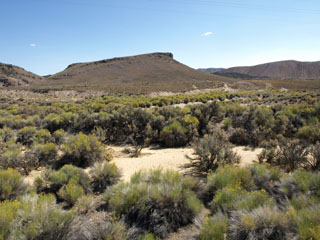

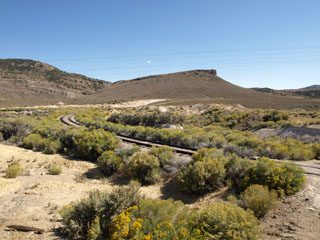
At Keystone, we turn south west to parallel White Pine County Road #44A and cross the top of the Keystone wye.

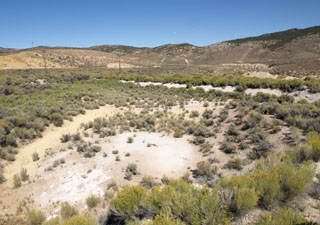
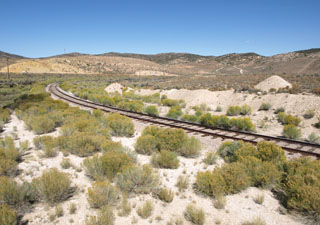
Backing south east on the first leg of the wye with White Pine County Road #44A running across the centre of these views above.
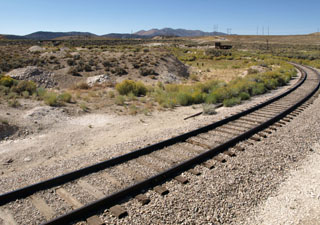


Here, the engineer runs #93 north east on the second leg of the wye to rejoin the main line so that we can front end back to Ely.
Silver was discovered at Keystone in the late 1860s by a wandering prospector, one of many drawn to the area by the discovery of silver ore at Eureka in 1864. The initial ore discovery at Keystone was as high as 600 oz of silver and $120 gold per ton, but efforts to locate other, similarly valuable deposits were fruitless.
The township of Keystone originated in 1868 as a company town for the Old Dominion Mining Company, but it was always more of a mining camp than a
town. Before long, the population had reached fifty, which supported
two saloons, but this initial interest soon declined.
Keystone Mine operated only intermittently throughout the
remainder of the 19th Century but, in 1910, another rich silver strike was made. From then until as late as 1990, a number of mining companies operated in the locality. Now, however, little remains other than a few old stone buildings.
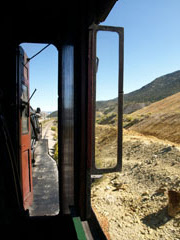
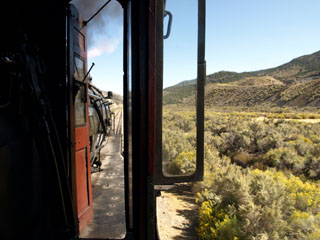
Above, two views from the engineer's side of the locomotive as we head back down to Ely. Gleason Creek is on the right. Highway 50 is just visible beyond the smokebox on the left.
On the down grade, there is no call for opening the throttle very far.
A little steam is required to keep the cylinders lubricated but, otherwise, my focus is on brake control. Too much brake and #93 begins to slow, too little and you feel the massive engine begin to surge forward under its own weight.
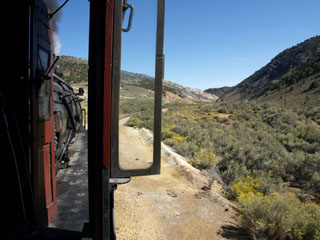

There are two tunnels on the route between Ely and Keystone.
Above, we are approaching the more modern northern tunnel. On the right, two rather shaky photos taken inside the tunnel. It's smoky, steamy and surprisingly hard to breathe inside, although it's not a very long tunnel.
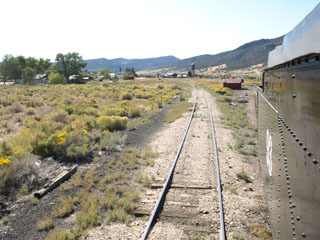
Looking back along the tender at Ely.
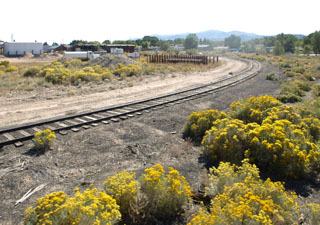
Here, we go onto Ely wye.
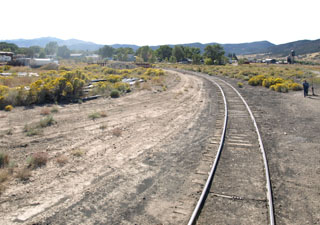
Looking along the eastern arm of the wye.

Looking back along the main line.

Pulling away from the main line.
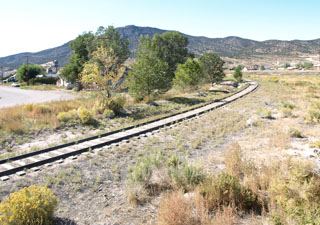
Approaching the western arm of the wye.
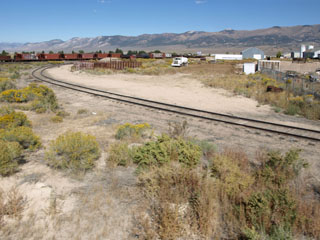
Looking along the eastern arm of the wye.
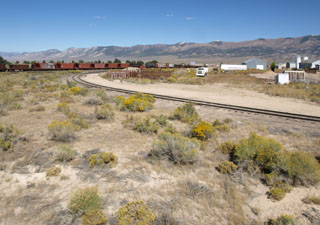
Another view of the eastern arm of the wye.
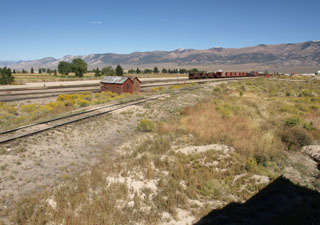
Rejoining the main line.
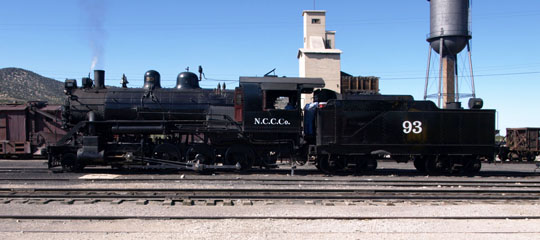
Above and right, #93
stands in the yard at the end of the trip. The engineer
has gone to get my certificate confirming that I have engineered the locomotive.
Ely is somewhat off the beaten track, but it's worth a visit. The countryside is quite spectacular, Ely is friendly and, if you decide to engineer one of the locomotives, you're in for a treat!
You can see more of #93, with it's partner locomotives, steam, diesel and electric, along with other equipment on the Nevada Northern Railway Museum page of this website. You can also see more footplate action on
the Sumpter Valley Railroad and Milwaukee Road #261 pages.
Related Links:
Locations along the NN #93 Route
Nevada Northern Railway Museum Website
At the Throttle of #93
Send a comment or query, or request permission to re-use an image.
Video Management have published a four DVD set Running a Steam Locomotive (click on the cover to search for these DVDs on Bookfinder.com)







